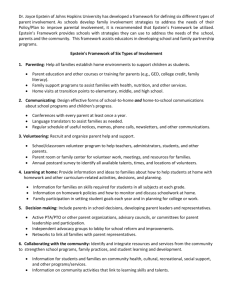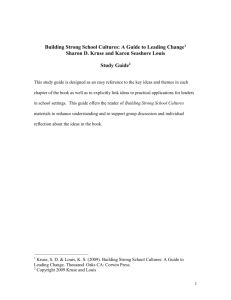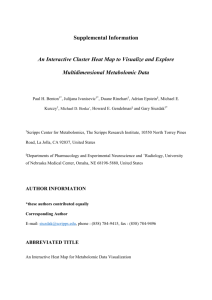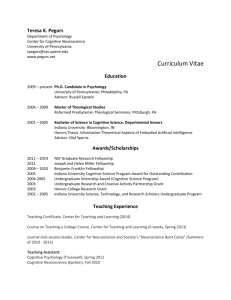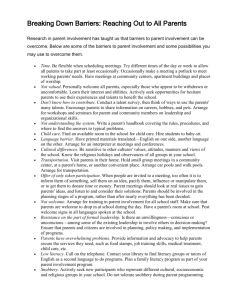this paper - Department of Sociology
advertisement
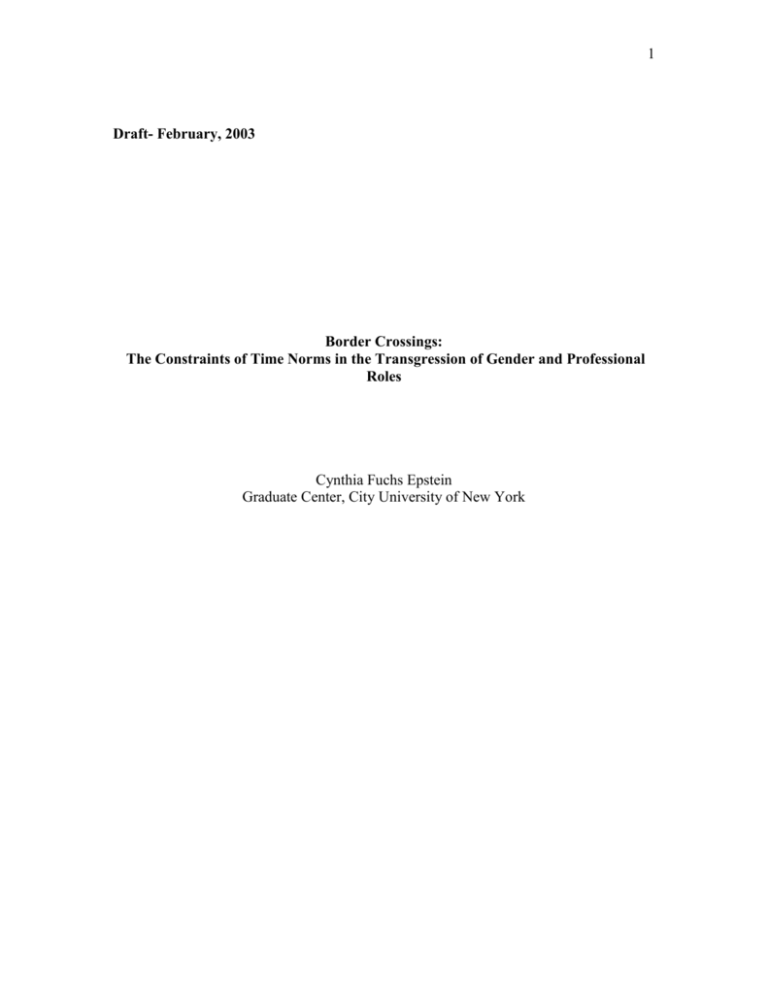
1 Draft- February, 2003 Border Crossings: The Constraints of Time Norms in the Transgression of Gender and Professional Roles Cynthia Fuchs Epstein Graduate Center, City University of New York 2 This paper is about cultural constraints limiting women’s and men’s bordercrossings into roles and statuses not traditional for their sex. It focuses primarily on the ways in which ideologies of time and gender ideology, and to a lesser extent, work ideologies are operationalized to limit individuals and groups who attempt to engage in boundary transgressions. The borders people draw—creating geographical or conceptual boundaries---that categorize and define—are a source both of conflict and of order (Durkheim 1903[19665]; Douglas 1966). Conflict, because a boundary creates a “we” group and an “other” group, invariably stirring invidious comparisons (Epstein, 1988), and order, because the boundaries are markers of a division of labor and of cooperation among those whose labor complements one another. People become invested in borders or boundaries; they see them as real, attributing them to some divine or genetic order, historical precedent, or political or economic arrangement. Boundaries also may create characteristics as well as mark them. For example; a boycott of a country may reduce it from a prosperous nation to a supplicant one; access to good nutrition and education may raise the intellectual level of a population. Social conventions that create a sex division of labor result in “women’s and men’s jobs” that prevent women from developing managerial and technical competence and give men public roles as workers and warriors, resulting in their selective incompetence in roles as caretakers of children. Further, certain roles are difficult or easy to perform depending on whether a person has access to social resources and various forms of human capital and whether they are within or beyond the gender pale. Although there has been some change in these effects, social forces continue to reinforce traditional views. 3 As we know, cultural views define boundaries and cultural, psychological and social mechanisms enforce them. In this paper I will focus on one set of cultural factors—ideologies of time use— and the processes by which their enforcement curtails men’s and women’s boundary crossings into role realms untraditional for their sex and which prevent transgression of the boundaries creating the division of labor between men and women. Like other boundaries, time designations such as “socially expected durations” (Merton 1984), create order and conflict. As Zerubavel (1981) has pointed out, temporal boundaries such as schedules, create order by segregating activities, marking the difference between private and public time. As he further observed, adherence to schedules are affected by one’s place in the occupational hierarchy, suggesting differential access to time constraints. Of course, boundaries of all types may be changed or ignored in spite of markers that seem natural or logical. And people may gain or lose the ability to cross them. For example, rivers and streams may create geographical boundaries that mark countries and regions, yet bridges and airplane travel may make them insignificant as borders. And the politics of negotiation and trade, or the exercise of raw power by conquerors or managers, may bridge the markers of territory. Social movements result in destroying boundaries that make certain jobs off limits to ethnic and racial minorities. Individuals and groups develop competencies, or benefit from social and technological changes in moving between the regions marked by boundaries as Christina Nippert-Eng (1996) has described. For example, today geographical boundaries and time zones are undercut by the use of email and faxes. Similarly, the use of computers and 4 development of other technology makes work boundaries between younger and older workers and men and women, permeable because most work no longer requires physical strength and gives many access to networks they might not otherwise have. Cell phones make physical location irrelevant although they, with other technologies create permeability between what I shall call “role zones”—the categories of time and space allocated to the performance of particular roles. Individuals may retreat from role demands by closeting themselves in automobiles during long commutes or use tape recorders and videos to make themselves “available” to their children although they are not physically present. Furthermore, borders create barriers that often seem impenetrable yet even the most severe invite transgression. This may happen when rewards are high enough, or identification with the other realm is strong, or barriers have become lax. Yet even as some East Germans found ways to bypass the Berlin Wall or Mexicans defy border guards to get to the U.S., many people accept the boundaries and stay put. This is often as much a matter of collective acceptance of a boundary as it is of the reality of barbed wire fences, guards, legal restrictions and lack of money and other resources. The walls that define occupational and sexual groups have no armed guards (at least not in the western world) or physical barriers to separate and segregate them. Many have stepped over the borders to take roles of those on the other side – sometimes in groups and sometimes individually. Yet many more trying change find they face constraints set by people acting out cultural scenarios. Of course, one person’s conception of a particular boundary may be loose while another person may be highly invested in keeping it strong. One boundary that draws often violent tensions is the one 5 marking motherhood. Some women who choose not to become mothers face violence from anti-abortion activists who seek by psychological and physical means to prevent their access to medical assistance. Less dramatically but more pervasive, many of the norms linked to motherhood specify hands-on attentiveness to children when roles might be shared with others (a “village,” perhaps!) (Clinton 1996). Rose Laub Coser, in her “defense of modernity” (1991) pointed out that in premodern society it was difficult to transgress boundaries because individual’s behavior was highly visible to other members of the community. Certainly, this surveillance extended to the use of people’s time. By engaging in commercial or playful activity on the Sabbath, for example, a violator risked severe punishment or social isolation. As Coser observed, in modern society, especially in urban life, what one does is not visible and so one is free to slip from role to role without the eye and accompanying strong arm of boundary keepers. Yet the loosening on one leel may come up against tightening in another. Our world—marked by ideologies offering freedom from ascription (Parsons 1951) and the promise of permitting the activation of achieved roles (to refer to an old designation)-offers individuals the promise of freedom to “be what they can be” to paraphrase a common American promise. And many individuals have indeed attempted to do so, with some success. We live in a world in which men and women violate conventional and historic role prescriptions that defining what they should do in their work and family roles. They may now perform more roles; they may have to. Modern society demands it and it is especially true for those who travel upward in social rank. Women have moved into 6 male-dominated spheres of work such as the legal profession and police work, and men are reconsidering their parental roles, and are performing more nurturing activities-mothering activities-- as fathers-- than they did before. Yet men and women face social controls that pressure and persuade them to conform to conventional roles and internalize norms that restrict them from exercising real choices. Power, lodged in everyday conventions, as Foucault (1977, Lamont and Wuthnow 1990) holds border crossing down. Public images of men as effete should they take on women’s occupational roles keep their numbers low in such women-dominated occupations as nursing, grade school teaching and clerical work. And women who become truck drivers, fire fighters (Chetkovich, 1997), coal miners (Padovic, 19 ) and stock and bond traders (Lewis 1989; Levin forthcoming; Fisher 2000) find that they are subjected to peer disapproval (Epstein 1992), and negative sanctions that range from sarcasm and joking to sexual harassment. Of course, controls at all levels of the social system operate to keep men and women in their “place” even at a time when social change is providing opportunities to move beyond the conventional boundaries of work and family roles (Epstein, 1988) and to move upward in rank. I believe this is particularly true for women moving into top jobs in society, where the time demands are high (Jacobs and Gerson, 1997; Maume and Bellas, forthcoming). Looking at the family as a system, married women moving into such jobs typically have spouses who are among the “highly placed managers and professionals, the well educated, and those who work in large [law] firms,” (Maume, forthcoming) and who tend to have the most time-demanding jobs. Yet they may accept an ideology of sharing. The women and men ideologically and economically motivated to attempt to transgress gender boundaries find themselves corralled and punished in ways 7 both subtle and direct, and often are prevented from moving beyond the boundaries invoked.. Some time ago I theorized (Epstein 1987) about the mechanisms available to individuals who wish to expand their number of roles, and to perform complex and demanding roles, including those not regarded as integrated and compatible. Holding many such roles has been regarded as potentially or inevitably stressful, leading in some cases to efforts to reduce the stress by casting off demanding roles. A woman who leaves a partnership track for a "mommy track" in a law firm is one example of this. Following the reasoning by Merton (1957) and Goode (1960) who noted that role strain might be controlled by activating a number of mechanisms, including “compartmentalizing, delegating, and protecting the time reserved for certain tasks” as well as casting off a problematic role. I suggested these mechanisms are available to some people and not others. (Epstein, 1981, 1996). I pointed out that privileged men are most able to use such mechanisms and that women and minority groups are less able to use them. This is due partly to differential access to material and cultural resources such as symbolic capital (e.g. rank carrying authority and legitimation). Women and minorities typically have not had the financial resources to delegate and find surrogates to perform some of their role obligations, or to protect them from intrusions while performing certain roles so they can turn to alternate activities. Furthermore, women live in cultural environments in which the use of such surrogates is disapproved. Men may use surrogates, as we shall see, as long as they do so conforming to traditional male roles. Women and minorities face more rules about how they use time. For women, this is because of the role obligations society imposes on them in the sphere of the family, 8 which undercuts full commitment to professional demands. Furthermore, and most importantly, they face often subtle cultural prohibitions on fully exploiting the mechanisms for making time expand by use of the privileges of authority and assertiveness attached to “male roles” which permit delegation, flexibility, and retreat from certain family obligations. Of course, most women and minorities and many working class men are lodged in occupations which do not offer the options of upper rank male privilege. They are subject to a regime of accountable time in a workplace structured by time clocks and strict rules on the job. But even at the blue collar level, men may be less subject to time surveillance. For example, I found in a study of telephone company workers in the mid 1980s that most women worked at easily monitored “inside” jobs and a sizable number of men at “outside” jobs where they were less likely to be in panopticon-like settings subject to the gaze of supervisors (Foucault, 1977). For men working in the professions, although they work hard and for long hours, they are nevertheless often masters of their schedules, free to take time off during the day, and to decide when they will arrive or leave. Although they too, of course, are subject to performance norms set by their professional peers, it is nevertheless the case that upper managers, and doctors and lawyers may leave the workplace without being accountable to others (Epstein, 1995). This is true whether they are taking time off to go to conferences, to have extended lunches and dinners, or to play golf or tennis or to have assignations with lovers. Professionals and executives can exercise this freedom because they can extend time by delegating part of their role responsibilities to secretaries, junior associates, research assistants or wives, and pass out of the screen visible to others as they take time off from role duties. This freedom, of 9 course, is not available to all high-level workers, but it is a possibility, one that is workable within the normative structure with social approval from peers, and most importantly, one not resulting in a sense of role conflict. As Thompson and Bunderson (forthcoming) point out, “the experience of worknonwork conflict may at least partially be explained by social-structural considerations…” and that “meaning-based conflict is more relevant for individuals in certain occupations, certain industries, or at different levels of the hierarchy.” (12) Thus, within the professions and managerial ranks, men and women are subject to different sets of norms regarding their use of time. These norms are geared to reinforcing gender norms in the occupational setting and reinforcing appropriate emotion norms to go with them. Men may labor long and hard-- with work-associated play included-- but women may not. Men may eat dinner and go to sports events with clients and define their activity as work time, as a result often delegating aspects of their work to assistants, but women feel less free to do so (Epstein, et.al 1999). But there are limitations on male privilege in delegating activities to others. They can do so when they conform to traditional gender roles. As I shall describe later, men may not work in roles outside the occupational setting --as caretakers of children or kin, for example-- without facing negative sanctions from their organizations and derision from peers and others as being less than “real men.” (Epstein, et.al. 1999). It is not only the availability of surrogates but also the legitimation of their use that is subject to gender ideology. Now that women have moved into occupations in which they can afford surrogates, at home and in the workplace, they face disapproval from the ideological left as well as the right, e.g. the condemnation of middle class 10 women for using the labor of immigrant women (Ehrenreich 1999); the “family values” agenda that supports women staying at home to care for children; motherhood ideology that specifies a mother’s “hands on” approach to childcare (Hays 1996); fears of possible dangers to the child from immigrant or minority childcare workers (Glassner 1999; Wrigley 1995); harm to the psychological or physical development of the child from “part-time” mothering (Epstein et.al. 1999); the harm to the woman from overwork, dualshifts or denial of her “true” nature (Barnett 19 ); and finally, that residual prejudice--the resistance of subordinates to taking orders from a woman. For men, manhood ideology means that sharing or helping women is regarded as ancillary rather than competitive with occupational roles. Multiple Roles The notion that women should take on many roles and can perform them competently and without stress or with stress of the positive kind (Selye 1974) is usually regarded as impossible, and it has generated a multitude of popular and scholarly works that define such activities as overburdening and problematic. When women “stretch” time; using it efficiently and pack it heavily with activities, they are regarded as deviants (Epstein 1987, 1995, Epstein et.al. 1999). I found in my studies of women lawyers ([1981] 1993;1995) that attorneys who do many things are regarded as “superwomen” and labeled not “real women.” They often face ridicule behind their backs or outright resistance from other women whose role-sets are narrow and from men who find them to be “ball busters.” (Epstein [1993] 1981) In my study of women lawyers in large firms, many of the young women interviewed scoffed at older women in their firms who “did it all,” finding them to be pitied. (Epstein, 1995). The very depiction of such concepts as 11 “role overload,” “role strain,” and work-family conflict suggests that taking on numerous activities must lead to stress and negative outcomes. I wrote in earlier papers (Epstein 1985, 1987; 1996), that women’s assumption of numerous roles (and the process of taking on multiple identities as a result) did not evoke negative reaction in the past because they typically were engaged in gender-appropriate activities in the home and in the workforce. Women worked on the farm, raised children, made clothes, and brought in the harvest. without public concern or notice. Even working in sweatshops or doing piecework at home was viewed as problematic only when public health problems seeped into the larger culture. However, when women began to move into occupational roles held jealously by men, a rhetoric of problematic social and mental disorder attached to the idea of “role overload” began to proliferate supported by an accompanying social science literature (Epstein 1985,Baruch and Barnett 1987). In a study of attorneys who attempted to solve the family-work conflict by working part-time (Epstein et. al, 1999), it was found that when women assumed multiple roles even on a limited basis they encountered hostility. Co-workers resented the women’s manipulation of time norms and viewed them as fulfilling neither work nor family norms. The term “neither “fish nor fowl;” was applied to a number of women in the study and expressed further in the words of one colleague,” If you want to be a mother, be a mother; if you want to be a lawyer, be a lawyer.” Some of this reaction came from the suspicion that colleagues would have to assume the part-timers’ obligations. Some colleagues were jealous of the part-timers attempt “to have it all.” 12 More than two decades ago, Marks (1977) and Sieber (1974) showed that accumulations of roles often engender pleasure and increase energy rather than strain on other roles, Others also found that people with many roles often produce more than those with few roles. I found (Epstein [1981] 1993), for example, in a study of large New York City law firms that of 41 women partners about three-quarters or 27 were married and 25 of them had children. Jonathan Cole and Harriet Zuckerman (1983) also report that in their study of scientists the most successful women were married (74 percent had children) and published more than their single counterparts. The work of scholars such as Rosalind Barnett (1996) show that dual-earner families indicate more life satisfaction than those in which only the man is the bread-winner. Yet, as Barnett points out there has been no accompanying “go for it!” ideology to express this collective experience. Of course, the people who manage these complex and multiple roles must make different use of their time than others who work and play during the conventional time periods allocated for them. There is no doubt that many people today are overworked both at work and in the family due to escalating time pressures (Epstein et. al. 1999; 2000). But certainly the popular and scholarly focus on “crisis” seems aimed particularly at women and not on men. Part of the reason is that the strains that are “felt” are imposed by an unyielding cultural ideology regarding time norms associated with gender. Women who work a conventional workday are performing within the realm of role acceptability. This is not unlike the women, who in the past, worked in conventional jobs as secretaries or teachers and were regarded as augmenting the family income but not as providing its basic bread. But women who work irregular hours are regarded as working in the time and space that 13 normatively are reserved for their performance of family roles. Women are not supposed to work during the dinner hour or on a weekend. They are supposed to be putting in time at home then. Only if they are working at jobs sex-labeled as female, can they deviate with approval (nurses working the night shift, for example). Women who do so in jobs labeled as male are apt to encounter disapproval. If, as a news reporter a woman has an assignment to cover a breaking story, or as a novelist, she feels the muse at the dinner hour, a woman is sanctioned for not subordinating her schedule to that of others in the family. Women are expected to be on tap for family roles on a regular daily basis, not four days a week or every other weekend, although men of privilege may participate in family life on these terms. Furthermore, schools and other institutions conform to a rigid schedule, not permitting children to stay after school should parents be held up. Only commercial establishments such as stores and banks have changed their hours to enable mothers who work to shop at odd hours. 14 Constraints on Men Men who transgress female role boundaries by taking on nurturing roles on a systematic basis such as working part-time to take care of children, also suffer social disapproval. that may prevents them from perfoming such roles altogether or for very long. In our study of part-time work in the legal profession (Epstein et al, 1999), the men we interviewed complained that it was more difficult for them to negotiate part-time schedules because managers did not regard their requests as legitimate as they did women’s. The same complaint was voiced by the men interviewed for a New York Times (Ligos, 2000) article on the “fear of taking paternity leave.” As it reported: “James M. Strauss did not consider himself a wimp. But Mr. Strauss, a Manhattan lawyer, was not going to take an extended leave of absence when his son Evan was born last June. One of the reasons: He feared that his co-workers would question his machismo. ‘If I said I was planning to take more than two weeks off, people would have looked at me askance.’ said Mr. Strauss”. Instead he took just three days of vacation to help his wife with their newborn. The article reported that very few men take advantage of the Family and Medical Leave Act passed seven years ago by Congress. “While their organizations may profess to be family friendly, their bosses are giving them the message that men who take leave are not very manly, or are somehow letting down the team.” (Ligos, 2000). A State trooper who applied for six weeks leave to care for his child while his wife was enrolled in nursing school was told by his supervisors that “a man’s job is to work, not to stay home with the kids.” The American Civil Liberties Union has represented state troopers in South Carolina and Maryland in sex discrimination suits based on their departments’ refusals to grant paternity leave (Balestier 2000). Other men interviewed for the New York Times article, from Harvard professors to lawyers, asserted that requests for family leave evoked threats that the men’s careers would be jeopardized were they to take leave 15 from their jobs to take on parental roles (clearly noted here as mother’s roles). The human resources manager for a major company suggested to an employee that he take a combination of vacation time and sick leave in order not to have the term “parental leave” put on his employee record. In our part-time study, the few men who chose part-time schedules in order to share child rearing faced sanctions including informal disapproval when they went to the playground with their children during the day. Women viewed them with suspicion; they were avoided because they might be 1) unemployed, 2) gay, 3) or on the prowl for sex. Stay-at-home mothers ignored them and often would not permit their children to play with the man’s children. What was deviant during the week, in the daytime, was tolerated on the weekend, when fathers who took children to the playground found other fathers to talk to and were given approval for spelling the mother for a few hours. The weekend schedule meant they were acting out a father’s role and not a mother’s role. Time Norms as Constraints on Women’s Careers In this paper I am not exploring the availability of services or of time for women in high power jobs but rather the legitimation of women’s use of such services or time manipulation and the of constraints on the expansion of family and childcare. I am suggesting that women are put in a double bind Just when they have achieved access to upper level jobs, jobs that make irregular time demands and overtime and involve subjective evaluation based on such markers of commitment as the demonstration of “face-time” evenings and weekends, both necessary for career advancement (Epstein, et al, 1995, 1999; Bailyn 1993; Fried 1998) they are made to feel guilty about using the mechanisms long available to men to cope with time pressures at work and in the family.. 16 Furthermore, should their male partners wish to help them in any systematic way by engaging in family roles during times when they are expected to be at work, they face negative sanctions, as pointed out above. Thus, we see how the ideologies tied to the gendered use of time restricts the boundary crossings by women who wish to move into male roles and by men who wish to perform more family roles. Identity and Time Norms One of the greatest problems facing the transgressors stems from the fact that social disapproval is often internalized and becomes an identity problem for both women and men. Their very stake in the “who” of “who they are” is called into question. Identity usually is regarded as derivative from socialization and the other components of personality structure, but many of us now argue that it is also situationally produced (Markus, Crane, Bernstein and Siladi 1981, Deaux and Major 1987, Stryker; Epstein 1996). Thompson and Bunderson (forthcoming) find that when individuals’ identities are anchored in certain roles but they are forced to spend time in alternative roles they experience a sense of conflict which they do not feel if their identity and activities match. Yet identity salience may be situationally triggered, they point out. Furthermore, when a person encounters disapproval for assuming a role not regarded as anchoring a proper identity, it can trigger guilt. Ideologies regarding appropriate role acquisition and the time norms attached to them, as well as to other understandings of the meaning of such constructs as the week, the work day and holidays (Zerubavel 1981) provide the context and values that order people’s sense of what they, as man or woman, ought to be doing at any given time. 17 Thus time norms as well as gender norms enter into the equations that constitute constraints on people’s deviation from established patterns. Ideologies of Time Other ideologies are entwined with time and gender norms to keep boundaries stable. One is the ideology of “greedy institutions” (Coser 1974) characteristic of professions and managerial ranks, the army, religious orders and other occupations which demand continual deligence. Greedy institutions demand that their members be on tap “all the time” subordinating other role demands. Greedy institutions incorporate gender distinctions. The family (Coser and Coser, 1974) is also a greedy institution in that it asks mothers to be available all the time. The specific norms vary from time to time and era to era. In the past, the wife was supposed to be available for her husband’s needs all the time. Indeed, women who applied for jobs as lawyers up until the 1980’s encountered employers who asked them how they could be good wives if they worked at a high demand occupation. “Go back to the kitchen,” male law students would taunt the few women in their classes when they stumbled on the answer to a professor’s question (Epstein, 1981). Of course, these questions are no longer asked nor are they considered “right” to ask. And wives feel they may ask husbands to share household work and cover for them at home if they have “extra’ work to do at the office. Although I found that many refrain from doing so because they feel it is in the family’s interest for the husband to ‘go for broke in his career;’ they still regard their time as expendable and their husbands’ time as inviolable. Some ideologies are persistent. And new versions of old ideologies support conventional assignment of roles and the time norms attached to them. Most insidious to 18 the ambitious woman worker is the ideology of “intensive mothering” that Sharon Hays (1996) has identified. This defines proper motherhood as putting the child first and meeting norms designating various child-centered activities such as after-school ballet lessons and sports activities requiring the mother to not only bring the child to the game but to stay while it’s played. Care for the child’s well being was extended to include care for the child’s psyche in the 1960’s and to include their social life and future networks in the 80’s and 90’s Even women who have full-time nannies and household help and wish to work long hours face disapproval from others and potentially internalized guilt for doing it. The husband typically is not encouraged or permitted to take over more than a modest amount of childcare. There is fear in the family he may suffer career consequences or it just seems a better economic bet to invest in the husband. As one lawyer in our study of part-time lawyers put it: We decided that the financial rewards of partnership versus the hours that I would have to work.were not worth it…and that it was better for me to go part time and take on the bigger role at home…It was better to invest in his career. (Epstein et. al. 1999) Wives were supportive of their husbands’ participation in childcare when the activity with the child was gender appropriate (e.g. coaching soccer) and did not interfere with the normal workday. Similarly, women who worked long hours at work when they were mothers of small children were often regarded as poor mothers by their male partners and particularly by younger women they knew who disapproved of their attempt to be “superwomen.” Such activity was regarded as hard-hearted, or entailed “sacrifices” that were unusual and deviant. Often it was believed that they had bad marriages or that they 19 were “missing” important markers of their children’s development such as seeing them take their first step or speak their first word. The ideology of motherhood is formed and reformed all the time. Fashions in childcare have changed. In the past, when upper and middle class women were not in the paid labor force there was not much ideology about the use of surrogates. Housekeepers and nannies took care of children to free their mothers for charitable work, socializing, sports, shopping or other activities. Working-class employed women depended on family members to take care of children or older children took care of younger children while their mothers worked. But women’s steady movement into the paid labor force coincided with a blossoming emphasis on mothering. Motherhood ideology turned to the psychological impact on the child of child rearing in the 1950s with a concentration on Freudian psychology and developmental psychology, particularly in the first years of the child’s life. Some child care professionals urged women to perform mothering in an ordered, scheduled way. Presumably this left women the option to do other things in the interim periods between feeding and tending to the child’s other needs. But this didn’t last long. Permissive, child-centered mothering generated new norms, such as ondemand feeding for infants. Today this has reached an extreme form in a movement, and to be carried around physically by day. The child is to be breast-fed into the toddler stage and beyond---sometimes as long as four or five years. Thus the “attachment mother” may never mesh work life with her home life but must fit all work into time left over—if there is any—from family roles. 20 The home schooling movement represents another ideology requiring educated women to be confined to the household all day in order to educate their children in the values of their group—sometimes right-wing fundamentalist groups but increasingly children of professionals who regard the public school system as incapable of meeting their expectations and hopes for their children. Here too, the mother is to be tied to the home and to mothering tasks and not to be free to do other things. Both of these ideologies are profoundly subversive of the movement of women into important and fulfilling work. . Multiple Roles Although these are extreme efforts to prevent balancing of home and work roles, all working women are subjected to the culture’s definition of multiple roles as pathological by the focus on work and family conflict. Rhetoric geared to conflict suggests that that both women and men are under stress rather than acting normally when they assume multiple roles which are not regarded as mutually supportive. It is often believed that the stress women feel is due to the total load of their responsibilities. Research shows that the weight is less important than the consistency of the demands on them (Epstein, 1996). Certain role combinations are complimentary but others may cause strains and conflicts in the identities one develops from attachment to those roles. However, conflict and consistency are products of social norms which prescribe “feeling rules”(Hochschild 1979) to which I would add “time rules” as well as 21 expected behaviors in many roles. And of course, organizations create structures that help or hinder women in performing multiple roles. (Epstein, 1996) Conclusion Work and family institutions are predicated on predictability and order. Only certain people from certain groups--usually men in high level professional or craft jobs-are granted the privilege of responding to time demands: that do not occur during regular work hours. Women doing these “male jobs” especially when they work at times women are supposed to be “at home” are often regarded as sexually available or homosexual or else selfish and uncaring. Similarly, men who take on household responsibility during time reserved for paid work encounter negative characterizations of their abilities and personality. Transgressions and border crossings can be successfully negotiated when men and women are given legitimation for the time allocations in the various roles that they hold. Then it is a matter of time management and not time conflict The current media hysteria about work/ family time conflict avoids mention of successful management. Yet thousands of women do accommodate to the role obligations of work and family. They do this by means large and small. Christina Nippert-Eng (1996) skillfully points out many small ways in which women manage many demands. Further, some do it by the judicious use of surrogates, by accomplishing role obligations at times that seem unusual to most others, by not conforming to faddish ideologies about intensive mothering, by rising high enough in their careers to behave as men do—delegating responsibility, having other people cover for them, and forcing 22 others to accommodate to their schedules. As one woman attorney in my first study of women attorneys (Epstein 1981) put it, “the higher you rise in an organization, the greater the freedom.” It would be fine if workplaces became more flexible and home life was also more accommodating to the schedules of its members. I found in my research that people can be innovative and accomplish much, if they don’t face the opprobrium set by norms that wrest from them the freedom to live their lives as idiosyncratically as they wish. It is doubtful, however, that this will be the usual case. Rather, society is too invested in maintaining boundaries of all sorts, with gender boundaries being one of the most profound and pervasive. Keeping women and men in their proper gender places is played out in a myriad of ways, and the rules attached to time management are among the most effective in limiting or preventing boundary transgressions. Thus, the widening of the opportunity structure for women, the result of years of political action, legislative activity and economic growth is countered by ideological attempts to prevent women from making full use of their potential for leadership in the economy and the society. 23 Bibliography Bailyn. Lotte. 1993. Breaking the Mold. N.Y.: The Free Press Balestier, Bruce. 2000. “Paternity Leave Slowly Catches On.” New York Law Journal. June 23. P. 24 Baruch, Grace and Barnett, Rosalind. 1986. “Role Quality: Multiple Role Involvement and Psychological Well-Being in Midlife Women.”Journal of Personality and Social Psychology. 51.578-581 Barnett, Rosalind C. and Caryl Rivers. 1997 “Working it Out: Can A Family Wreck Your Career?”Pitsburgh Post Gazette. May 4 Bourdieu. Pierre. 1984.Distinction: A Social Critique f the Judgment of Taste. Cambridge Mass.:Harvard University Press Cole, Jonathon and Harriet Zuckerman. 1983. “Marriage, Family and Women’s Research Performance.” Paper presented at the American Sociological Association Meeting, N.Y. Coser, Rose Laub. 1991. In Defense of Modernity: Role Complexity and Individual Autonomy. Stanford, Ca. : Stanford University Press Coser, Rose Laub. 1975. “Stay Home Little Sheba: On Placement, Displacement and Social Change. Social Problems. 22: 470-79. Coser, Lewis. 1974. Greedy Institutions: Patterns of Undivided Commitment .N.Y. The Free Press. 24 Coser, Rose and Lewis Coser. 1974. “The Housewife and the Greedy Institution of the Family.” In Lewis Coser. Greedy Institutions Crosby, Faye. (Ed.) 1987. Spouse, Parent Worker: On Gender and Multiple Roles. New Haven: Yale University Press. Clinton, Hillary Rodham. 1996. It Takes a Village and Other Lessons Children each Us. N.Y.: Simon and Schuster Chetkovich, Carol. 1997. Real Heat: Gender and Race in the Urban Fire Service. New Brunswick, N.J.: Rutgers University Press Deaux, Kay.and Brenda Major. 1987. “Putting Gender Into ontext: An Interactive Model of Gender-Related Behavior.” Psychological Review94-2 169-387 Douglas, Mary. 1966 Pruity and Danger: An Analysis of Concepts o Pollution and Taboo. London: Routledge and Keegan Paul Durkheim, Emile.[1911] 1965. The Elementary Forms of the Religious Life. N.Y.: The Free Press Ehrenreich, Barbara. 1999. Atlantic Monthly Epstein, Cynthia Fuchs, Carroll Seron, Bonnie Oglensky and Robert Sauté. 1999. The Part-Time Paradox: Time Norms, Professional Life, Family and Gender. N.Y. Routledge Epstein, Cynthia Fuchs. 1995. "Glass Ceilings and Open Doors: The Mobility of Women in Large Corporate Law Firms," (with Robert Sauté, Bonnie Oglensky and Martha Gever), Fordham Law Review, LXIV, No. 2 November. 291-449 Epstein, Cynthia Fuchs. 1996. “The Protean Woman. Anxiety and Opportunity.” In Charles B. Strozier and Michael Flynn, Eds. Trauma and Self. N.Y. (check this) Rowman & Littlefield Publishers, Inc. 25 Epstein, Cynthia Fuchs. 1992. “Tinkerbells and Pinups” in Michele Lamont and Michel Fournier. Cultivating Distinctions: Chicago. University of Chicago Press Epstein, Cynthia Fuchs. 1981. Women In Law. N.Y. Basic Books.(Second Edition, 1993 University of Illinois Press) Epstein, Cynthia Fuchs. 1988. Deceptive Distinctions. New Haven: Yale University Press and N.Y.: The Russell Sage Foundation. Epstein, Cynthia Fuchs.1987. “Multiple Demands and Multiple Roles: The Conditions of Successful Management. in Faye J.Crosby (ed.) Spouse, Parent, Worker. New Haven: Yale University Press Epstein, Cynthia Fuchs. 1985 “The Politics of Stress: Public Visions, Private Realities.” American Journal of Psychoanalysis. 45: 3 282-290 Foucault, Michel. 1977 Discipline and Punish. N.Y.: Vintage Fisher, Melissa. 2000. “Women on Wall Street: Gender, Class, Culture and History in Finance.” Unpublished paper, Columbia University, N.Y. Glassner, Barry. 1999. The Culture of Fear: Why Americans are Afraid of the Wrong Things. N.Y.: Basic Books Goode. William J., 1960. “A Theory of Role Strain” American Sociological Review.25:483-96 Hays, Sharon. 1996. The Cultural Contradictions of Motherhood. New Haven: Yale University Press Hochschild, Arlie. 1979.”Emotion Work, Feeling Rules and Social Structure.” American Journal of Sociology.85:2 November. 551-595 26 Jacobs, Jerry A., and Kathleen Gerson, 1997. “The endless day or the flexible office: Working hours, work-family conflict, and gender equity in the modern workplace.” A report to the Alfred P. Sloan Foundation. Lamont, Michele, and Robert Wuthnow. 1990. “Betwixt and Between: Recent Cultural Sociology in Europe and the United States.” In George Ritzer, ed. Frontiers of Social Theory: The New Syntheses. N.Y.: Columbia University Press. 287-315 Levin, Peter (forthcoming 2001) “Gendering the Market: Temporality, Work and Gender on a National Futures Exchange.” Work and Occupations Lewis, Michael. 1989. Liar’s Poker N.Y.: Norton Ligos, Melinda. 2000. “The Fear of Taking Maternity Leave.” The New York Times May 31. G1 Marks, Stephen. 1977.“Multiple Roles and Role Strain: Some Notes on Human Energy, Time and Commitment.” American Sociological Review. 42: 921-936 Markus, H, M, M. Crane, S. Bernstein, and M. Siladi. 1982. “Self-Schemas and Gender.” Journal of Personality and Social Psychology. 42. 38-50 Maume, David J. Jr, and Marcia L. Bellas. (forthcoming. 2001) “’The Overworked American’ or the ‘Time Bind’?: Assessing Competing Explanations for Time Spent in Paid Labor.” The American Behavioral Scientist. Merton, Robert K. 1984. “Socially Expected Durations: A Case Study in Concept Formation.” In Walter Powell and Richard Robbins (Eds.) in Conflict and Consensus: A Festrift in Honor of Lewis A. Coser. N.Y.: The Free Press. 262-286 Merton, Robert K. 1957. Social Theory and Social Structure. Glencoe. Illinois: The Free Press. 27 Nippert-Eng, Christina. 1996. Home and Work: Negotiating Boundaries Through Everyday Life. Chicago: University of Chicago Press Reskin, Barbara and Padovic, Irene Parsons, Talcott. 1951. The Social System. Glencoe, Illinois.: The Free Press Seyle, Hans.1974. Stress Without Distress. Philadelphia: Lippencott Seyle, Hans. 1956. The Stress of Life.New York: McGraw Hill Sieber, Sam “1974. “Toward a Theory of Role Accumulation.” American Sociological Review. 39: 567-578 Thompson, Jeffery. A. and J. Stuart Bunderson. (Forthcoming, 2001). “Work/Non-Work Conflict and the Phenomenology of Tme: Beyond the Balance Metaphor.” Work and Occupations. Thoits, Peggy. 1987. “Multiple Identities and Psychological Well-being: A Reformation and Test of the Social Isolation Hypothesis.” American Sociological Review. 48: 174-187 Wrigley, Julia. 1995.Other People’s Children. N.Y.:Basic Books Zerubavel, Eviatar. 1981. Hidden Rhythms: Schedules and Calendars in Social Life. Chicago: The University of Chicago Press.
